Famous cultural art refers to significant works of art that embody the values, beliefs, and experiences of the cultures they represent. This art transcends mere aesthetics, impacting societies and crafting narratives that define eras. These artworks resonate deeply, preserving stories that span generations, from ancient sculptures to modern masterpieces.
The Top Famous Cultural Art Pieces You Should Know
Throughout history, there are specific artworks that have not only captured imaginations but have also influenced cultural narratives and societal perspectives. Below are some of the most recognized and celebrated pieces of cultural art.
1. Mona Lisa by Leonardo da Vinci
- Year: c. 1503-1506
- Origin: Italy
- Significance: Perhaps the most famous painting in the world, the Mona Lisa is renowned for her enigmatic expression. It is a pinnacle of Renaissance art and highlights the mastery of da Vinci in human emotion and light.
2. The Last Supper by Leonardo da Vinci
- Year: 1495-1498
- Origin: Italy
- Significance: A fresco that illustrates the final meal of Jesus with his disciples, this work masterfully employs perspective and character expression to convey deeper theological themes.
3. Starry Night by Vincent van Gogh
- Year: 1889
- Origin: France
- Significance: This iconic piece captures van Gogh’s swirling night sky filled with stars, revealing his emotional turmoil and unique perspective on nature.
4. The Birth of Venus by Sandro Botticelli
- Year: c. 1484-1486
- Origin: Italy
- Significance: Botticelli’s masterpiece represents the birth of the goddess Venus from the sea, celebrating beauty and love with ethereal grace.
5. Guernica by Pablo Picasso
- Year: 1937
- Origin: Spain
- Significance: This monumental canvas serves as a political statement against war, depicting the horrors of the bombing of Guernica during the Spanish Civil War.
Artistic Impact Across Cultures
Here’s a comparative table showcasing various renowned cultural art forms across different regions:
| Region | Artwork | Artist | Year |
|---|---|---|---|
| Africa | Nok Sculpture of a Seated Man | Unknown | c. 500 BC |
| Asia | The Great Wave off Kanagawa | Katsushika Hokusai | 1831 |
| Europe | The Scream | Edvard Munch | 1893 |
| North America | American Gothic | Grant Wood | 1930 |
| South America | The Kiss | Gustav Klimt | 1907-1908 |
Cultural Art and Its Evolution
Cultural artworks evolve with time but often retain ties to their historical context. Each piece varies by technique, medium, and thematic essence, reflecting societal shifts and personal expressions of artists. For instance, the Impressionist movement broke away from the rigid norms of academic painting, introducing light, color, and emotion into their work.
Key Art Movements and Their Examples
-
Renaissance
- Example: The School of Athens by Raphael
- Significance: This fresco embodies philosophy blending with art, showcasing the unity of humanism and classical knowledge.
-
Baroque
- Example: The Night Watch by Rembrandt
- Significance: This artwork captures dramatic lighting and action, infusing vivid storytelling through painting.
-
Modernism
- Example: Campbell’s Soup Cans by Andy Warhol
- Significance: This piece represents the fusion of culture with consumerism, providing commentary on mass production.
-
Post-Modernism
- Example: The Physical Impossibility of Death in the Mind of Someone Living by Damien Hirst
- Significance: This controversial installation plays with ideas of death and reality, challenging perceptions of art itself.
FAQs about Famous Cultural Art
What makes a piece of art "cultural"?
Cultural art typically reflects the beliefs, history, and aesthetics of a specific society or community, often conveying deeper meanings and narratives tied to the cultural identity.
Which artworks have had the most significant impact on society?
Artworks like Guernica, the Mona Lisa, and The Last Supper have profoundly influenced societal perceptions of history, spirituality, and politics, standing as icons of their respective cultures.
How do artists incorporate cultural elements into their works?
Artists may draw from historical context, use traditional Techniques, or incorporate local materials and themes to express cultural narratives and values in their artwork.
Where can I view famous cultural artworks?
Many famous cultural artworks can be viewed in museums worldwide, such as the Louvre in Paris for the Mona Lisa or the Museum of Modern Art in New York for works by Andy Warhol. For more information, visit My Modern Met.

By studying famous cultural art, one can appreciate the brilliance and creativity of human expression throughout history. Each piece serves as a testament to our collective experiences, shaping the world through the perspectives that art introduces. Whether it’s through ancient sculptures or contemporary paintings, the impact of art is undeniable and enduring.
